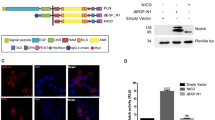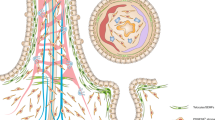Abstract
The Notch signalling pathway plays a crucial role in specifying cellular fates in metazoan development by regulating communication between adjacent cells1,2. Correlative studies suggested an involvement of Notch in intestinal development. Here, by modulating Notch activity in the mouse intestine, we directly implicate Notch signals in intestinal cell lineage specification. We also show that Notch activation is capable of amplifying the intestinal progenitor pool while inhibiting cell differentiation. We conclude that Notch activity is required for the maintenance of proliferating crypt cells in the intestinal epithelium.
This is a preview of subscription content, access via your institution
Access options
Subscribe to this journal
Receive 51 print issues and online access
$199.00 per year
only $3.90 per issue
Buy this article
- Purchase on Springer Link
- Instant access to full article PDF
Prices may be subject to local taxes which are calculated during checkout




Similar content being viewed by others
References
Artavanis-Tsakonas, S., Rand, M. D. & Lake, R. J. Notch signaling: cell fate control and signal integration in development. Science 284, 770–776 (1999)
Greenwald, I. LIN-12/Notch signaling: lessons from worms and flies. Genes Dev. 12, 1751–1762 (1998)
Kimble, J. & Simpson, P. The LIN-12/Notch signaling pathway and its regulation. Annu. Rev. Cell Dev. Biol. 13, 333–361 (1997)
Weinmaster, G. The ins and outs of notch signaling. Mol. Cell. Neurosci. 9, 91–102 (1997)
Shen, Q. et al. Endothelial cells stimulate self-renewal and expand neurogenesis of neural stem cells. Science 304, 1338–1340 (2004)
Varnum-Finney, B. et al. Pluripotent, cytokine-dependent, hematopoietic stem cells are immortalized by constitutive Notch1 signaling. Nature Med. 6, 1278–1281 (2000)
Jensen, J. et al. Control of endodermal endocrine development by Hes-1. Nature Genet. 24, 36–44 (2000)
Yang, Q., Bermingham, N. A., Finegold, M. J. & Zoghbi, H. Y. Requirement of Math1 for secretory cell lineage commitment in the mouse intestine. Science 294, 2155–2158 (2001)
Jenny, M. et al. Neurogenin3 is differentially required for endocrine cell fate specification in the intestinal and gastric epithelium. EMBO J. 21, 6338–6347 (2002)
Pinto, D., Robine, S., Jaisser, F., El Marjou, F. E. & Louvard, D. Regulatory sequences of the mouse villin gene that efficiently drive transgenic expression in immature and differentiated epithelial cells of small and large intestines. J. Biol. Chem. 274, 6476–6482 (1999)
Madison, B. B. et al. Cis elements of the villin gene control expression in restricted domains of the vertical (crypt) and horizontal (duodenum, cecum) axes of the intestine. J. Biol. Chem. 277, 33275–33283 (2002)
Maunoury, R. et al. Developmental regulation of villin gene expression in the epithelial cell lineages of mouse digestive and urogenital tracts. Development 115, 717–728 (1992)
Maunoury, R. et al. Villin expression in the visceral endoderm and in the gut anlage during early mouse embryogenesis. EMBO J. 7, 3321–3329 (1988)
el Marjou, F. et al. Tissue-specific and inducible Cre-mediated recombination in the gut epithelium. Genesis 39, 186–193 (2004)
Murtaugh, L. C., Stanger, B. Z., Kwan, K. M. & Melton, D. A. Notch signaling controls multiple steps of pancreatic differentiation. Proc. Natl Acad. Sci. USA 100, 14920–14925 (2003)
Hofer, D. & Drenckhahn, D. Cytoskeletal markers allowing discrimination between brush cells and other epithelial cells of the gut including enteroendocrine cells. Histochem. Cell Biol. 105, 405–412 (1996)
Bry, L. et al. Paneth cell differentiation in the developing intestine of normal and transgenic mice. Proc. Natl Acad. Sci. USA 91, 10335–10339 (1994)
Ohtsuka, T. et al. Hes1 and Hes5 as Notch effectors in mammalian neuronal differentiation. EMBO J. 18, 2196–2207 (1999)
Zine, A. & de Ribaupierre, F. Notch/Notch ligands and Math1 expression patterns in the organ of Corti of wild-type and Hes1 and Hes5 mutant mice. Hear. Res. 170, 22–31 (2002)
Lee, J. C. et al. Regulation of the pancreatic pro-endocrine gene neurogenin3. Diabetes 50, 928–936 (2001)
Go, M. J., Eastman, D. S. & Artavanis-Tsakonas, S. Cell proliferation control by Notch signaling in Drosophila development. Development 125, 2031–2040 (1998)
Capobianco, A. J., Zagouras, P., Blaumueller, C. M., Artavanis-Tsakonas, S. & Bishop, J. M. Neoplastic transformation by truncated alleles of human NOTCH1/TAN1 and NOTCH2. Mol. Cell. Biol. 17, 6265–6273 (1997)
Gerdes, J., Schwab, U., Lemke, H. & Stein, H. Production of a mouse monoclonal antibody reactive with a human nuclear antigen associated with cell proliferation. Int. J. Cancer 31, 13–20 (1983)
Fath, K. R., Obenauf, S. D. & Burgess, D. R. Cytoskeletal protein and mRNA accumulation during brush border formation in adult chicken enterocytes. Development 109, 449–459 (1990)
Louvard, D., Kedinger, M. & Hauri, H. P. The differentiating intestinal epithelial cell: establishment and maintenance of functions through interactions between cellular structures. Annu. Rev. Cell Biol. 8, 157–195 (1992)
van Es, J. et al. Notch pathway/γ-secretase inhibition turns proliferative cells in intestinal crypts and neoplasia into Goblet cells. Nature doi:10.1038/nature03659 (this issue)
Crosnier, C. et al. Delta-Notch signalling controls commitment to a secretory fate in the zebrafish intestine. Development 132, 1093–1094 (2005)
Korinek, V. et al. Depletion of epithelial stem-cell compartments in the small intestine of mice lacking Tcf-4. Nature Genet. 19, 379–383 (1998)
Galceran, J., Sustmann, C., Hsu, S. C., Folberth, S. & Grosschedl, R. LEF1-mediated regulation of Delta-like1 links Wnt and Notch signaling in somitogenesis. Genes Dev. 18, 2718–2723 (2004)
Sancho, E., Batlle, E. & Clevers, H. Live and let die in the intestinal epithelium. Curr. Opin. Cell Biol. 15, 763–770 (2003)
Ito, T. et al. Basic helix–loop–helix transcription factors regulate the neuroendocrine differentiation of fetal mouse pulmonary epithelium. Development 127, 3913–3921 (2000)
Acknowledgements
We thank K. Isselbacher, A. McClatchey, M. Curto and I. Saotome for technical help, discussions and critical reading of the manuscript. S.A.-T. was supported by the National Institutes of Health. S.R. and D.L. were supported by the Association pour la Recherche sur le Cancer and Biologie du développement et physiologie intégrative.
Author information
Authors and Affiliations
Corresponding author
Ethics declarations
Competing interests
Reprints and permissions information is available at npg.nature.com/reprintsandpermissions. The authors declare no competing financial interests.
Supplementary information
Supplementary Figure S1
Cre-mediated over-expression of activated Notch. (PDF 94 kb)
Supplementary Figure S2
Disruption of the rostro-caudal wave of intestinal differentiation elicited by Notch activation during embryonic development. (PDF 115 kb)
Rights and permissions
About this article
Cite this article
Fre, S., Huyghe, M., Mourikis, P. et al. Notch signals control the fate of immature progenitor cells in the intestine. Nature 435, 964–968 (2005). https://doi.org/10.1038/nature03589
Received:
Accepted:
Issue Date:
DOI: https://doi.org/10.1038/nature03589
This article is cited by
-
NOTCH localizes to mitochondria through the TBC1D15-FIS1 interaction and is stabilized via blockade of E3 ligase and CDK8 recruitment to reprogram tumor-initiating cells
Experimental & Molecular Medicine (2024)
-
Paneth-like cells produced from OLFM4+ stem cells support OLFM4+ stem cell growth in advanced colorectal cancer
Communications Biology (2024)
-
Intestinal stem cells: guardians of homeostasis in health and aging amid environmental challenges
Experimental & Molecular Medicine (2024)
-
Ubiquitin-specific protease 28: the decipherment of its dual roles in cancer development
Experimental Hematology & Oncology (2023)
-
Poly-β-hydroxybutyrate alleviated diarrhea and colitis via Lactobacillus johnsonii biofilm-mediated maturation of sulfomucin
Science China Life Sciences (2023)
Comments
By submitting a comment you agree to abide by our Terms and Community Guidelines. If you find something abusive or that does not comply with our terms or guidelines please flag it as inappropriate.



